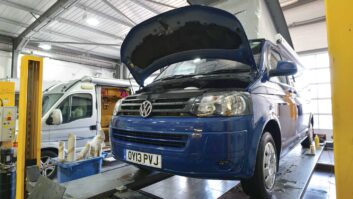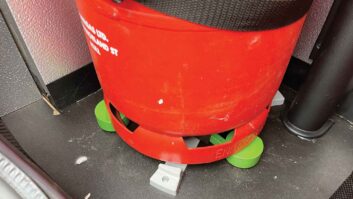We use a selection of energy sources in our motorhomes: these include diesel, petrol or LPG for road fuel, LPG for cooking and heating, mains hook-up for 230V appliances and, of course, batteries for our 12V needs. Here, we’re talking about the latter.
We can consider a battery as a fuel tank because it’s a simple energy store, but to hold that energy it obviously has to be put in there first, just like refilling your diesel or petrol tank. A good charging system is therefore of major importance.
You might think that all batteries are the same, but it’s not that simple. Batteries store electrical energy by converting it into chemical energy. In a typical lead/acid battery, for example, the chemical compounds inside are altered during charging, and revert during discharging – so it follows that not all batteries are born equal.
There are quite a few different types of battery that are used in motorhomes: standard wet lead/acid, sealed wet lead/acid, absorbed glass mat (AGM) and gel or lithium ion; plus, lithium iron phosphate has now joined the fray.
Of all these, a standard wet lead/acid is the cheapest option because it’s the oldest technology and is the least expensive to manufacture. Sealed wet lead/acid is almost the same, but the cells aren’t freely vented to atmosphere.
AGM is a relatively new technology. The plates use glass-fibre matting that absorbs the electrolyte and gives better deep-cycle characteristics; it makes the battery spillproof, too. Gel batteries are similar, but the electrolyte has been turned into a gel; again it’s spillproof. Its design makes it more suited to deep discharging, but less suitable for high-current applications.
Lithium ion (LiIon) is a much newer technology that gives great deep-cycle properties and a lighter weight. It’s a dry cell battery, so there’s no electrolyte to spill, and it has fast charging abilities. However, up to now they’ve been quite expensive, and do require a different charging system to a standard lead/acid battery.
The new boy on the block is lithium iron phosphate (LiFePo). It gives even better storage capacity for similar dimensions, plus great deep-cycle abilities, and can even (reputedly) survive being left in a discharged state. At the moment they are painfully expensive, however.
Starter or leisure battery?
Of all of these types, we’re only currently concerned with lead/acid, gel and AGM: the two newer technologies are still quite rare in motorhomes. Lead/acid batteries have been around since 1859; and while the exact make-up is different in gel and AGM, the basic technology is the same.
There are different types of lead/acid battery, depending on their intended use. Starter batteries are designed to give high current demand for short bursts, then to be recharged quickly. A leisure battery, on the other hand, is designed to deliver lower current for a longer time, and be discharged to a lower level. Leisure batteries don’t like high charging currents, so will generally take longer to fully recharge. AGM and gel batteries are simple variations on the theme and (as far as we’re concerned here) fall into the leisure battery category.
You can of course use a starter battery for leisure purposes and, as long as you don’t excessively discharge it repeatedly, it will serve its purpose quite well. This is particularly the case if you primarily use main campsites with hook-up, where all your electrical energy needs are catered for from the mains.
A starter battery isn’t going to cut the mustard for anyone camping extensively off-grid, however: that really requires a good-quality, genuine deep-cycle leisure battery. Cost will generally be a good indicator, and you really do get what you pay for. It’s worth going for a known brand name, too. Varta, Bosch, Yuasa and Exide are four well-known manufacturers, and some may even make batteries for other companies; but many of the cheap batteries are likely to be starter types in disguise. Sadly there’s no easy way to tell them apart without cutting them open – and you really don’t want to do that.
The most important thing to remember about batteries is to look after them, try not to over-discharge them and, when they are discharged, recharge them fully as soon as possible – this generally requires being connected to hook-up for 24 hours.
A keen motorcaravanner, Practical Motorhome’s technical expert Diamond Dave runs his own leisure vehicle workshop. Find out more at Dave Newell Leisure Vehicle Services.
You might think that all batteries are the same, but it’s not that simple









